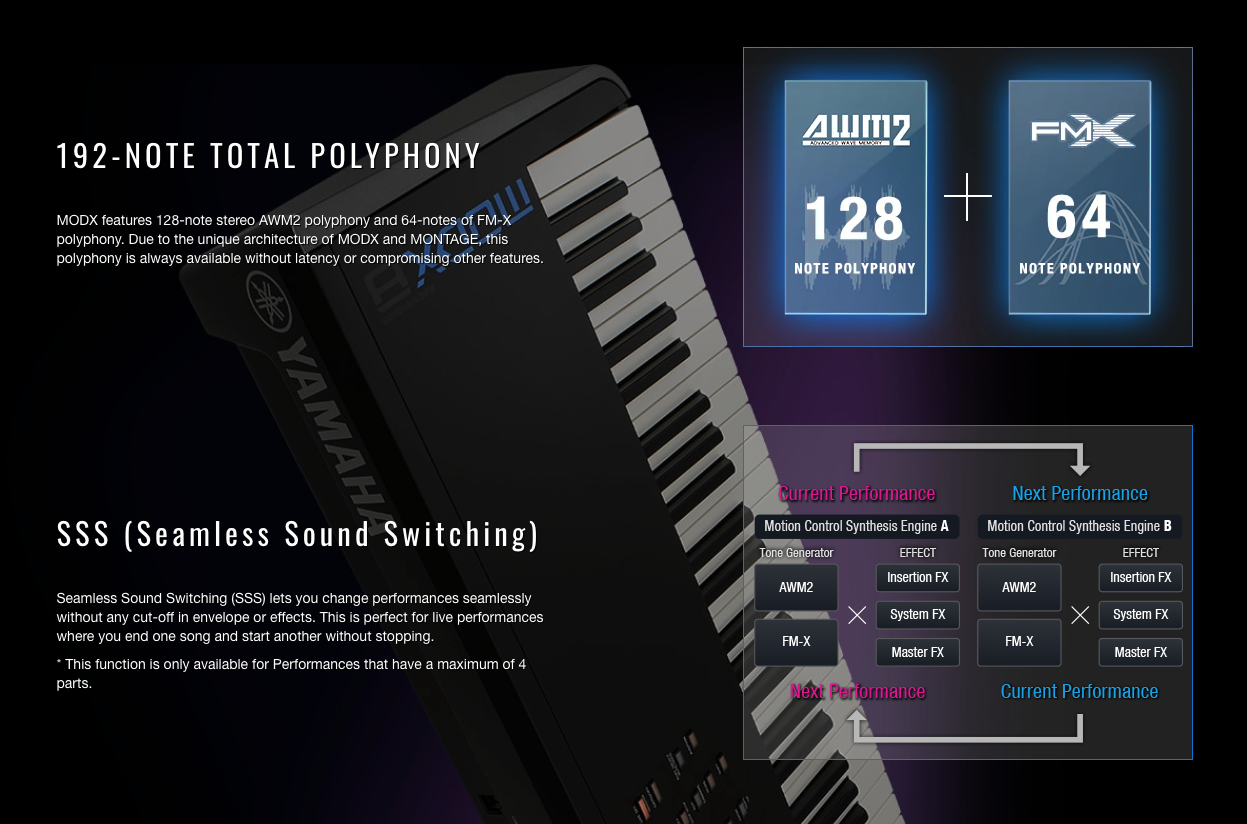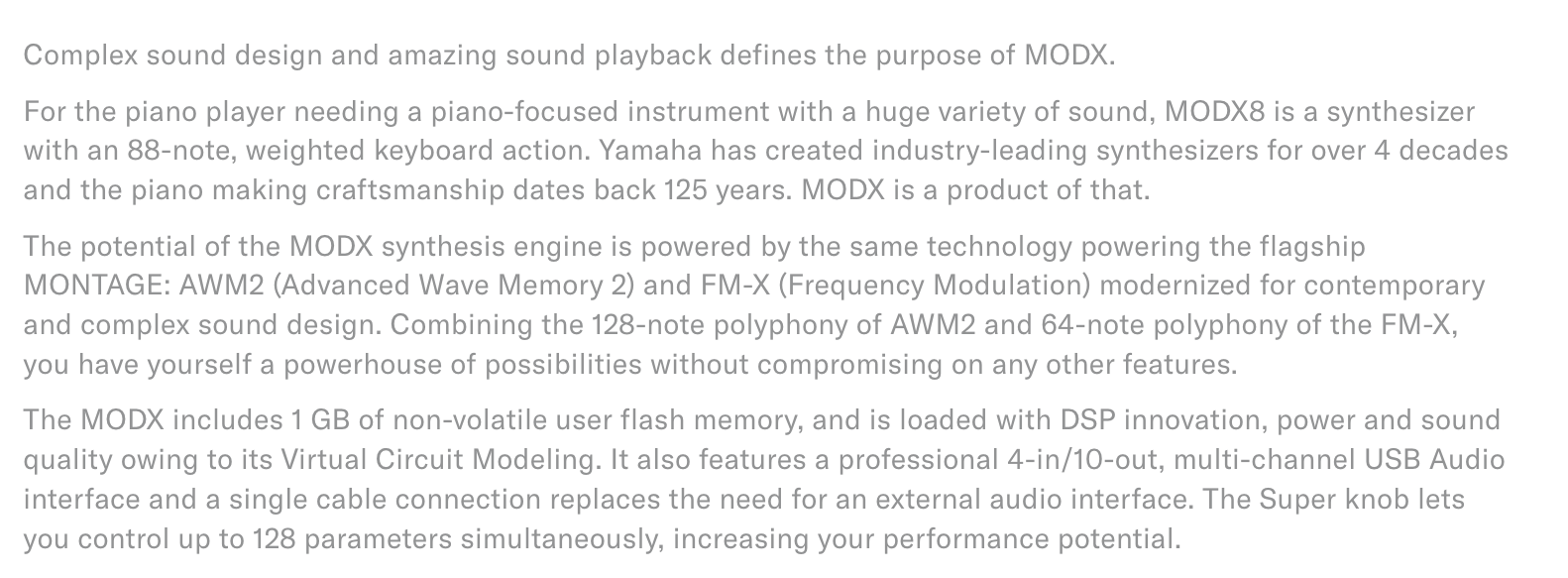Yamaha claiming 128 note polyphony by this means of Elements inside Parts is, at best, naively deceptive.
The documentation here from Yamaha has been fairly up-front about AWM2 polyphony stemming from individual elements. How polyphony is to be calculated is unique to the synth's architecture and synth engine(s) used. FM-X is relatively more simplistic to determine since we only deal with calculations at the Part level (not operator).
A random search shows in 2012 a user describing that basically all major manufacturers arrive at polyphony count in an industry standard way. In nearly the same way. So if there is deception then the entire industry is participating.
Source: https://www.harmonycentral.com/forums/topic/139776-korg-radias-polyphony/
All modern ROMplers use layering in patches (Yamaha calls a layer an "element", Roland calls it a "tone", Korg calls it "single" or "double", etc.) so the math is easy:
Minimum notes = Max polyphony / (number of layers X samples per layer)
Where the above says that each "layered" element in Yamaha architecture consumes a unit of polyphony.
Not that Wikipedia stands up to strict peer review (in other words, normally not definitive) - but it's a relatively safe place to fish for what would be regarded as "common knowledge". And, to that extent https://en.wikipedia.org/wiki/Sample-based_synthesis implies that polyphony is calculated at the individual sample level and that single instruments, as a "downside" of sampling technology, sometimes elects to layer multiple samples to achieve realism. These individual samples are "elements" in Yamaha land. So again, it appears that something not-so-deceptive is being described here.
At best an individual instrument may consume only one unit of polyphony per key pressed. "Common knowledge" suggests that ROMplers often consume more units of polyphony when a single key is pressed depending on sample utilization of the sound(s) used.
Furthermore, since Yamaha is aware of these impacts - they generally construct Parts that strive to serially chain samples and/or selectively enable samples depending on [ASSIGN 1/2], velocity, note range, superknob, etc. This brings down the effective utilization down to a low level. There are very detailed exceptions where attempts to keep element utilization low are tossed out purposefully. An AWM2 "emulated" organ with full drawbar control is one such example. Because each drawbar is itself an element and all of these elements are meant to be "ON" at the same time. If you take such a Part (Part 1 of All 9 Bars!) and replicate this across all slots (Parts 2-8) - you'll be able to run out of polyphony. And this would be considered "abuse" in terms of the resources available. Another framing of this is that it would just be a bad idea to knowingly take the highest utilization Part and replicate it many times. That's not a smart move from a programming perspective where the task would be to manage the resources given in order to achieve a musical outcome (one of those goals to avoid running into the polyphony cap).
Current Yamaha Synthesizers: Montage Classic 7, Motif XF6, S90XS, MO6, EX5R
All interesting and wonderful until you take a look at their product pages that sell these things.
Then it's "AWM2 Polyphony"
Which is Parts!
Both by inference and implication.
Top-line "Specs" page:
Source: https://usa.yamaha.com/products/music_production/synthesizers/modx/specs.html#product-tabs
AWM2: 128 (max.; stereo/mono waveforms)
A waveform is not a Part-level property so it's in conflict with the Part-level interpretation.
... I do agree that learning what a "waveform" is requires some digging - but the common misinterpretation that this means "sample" (since stereo/mono is paired here) does not lead you far astray. The distinction between "sample" and "element" and "waveform" is more semantics (yes, each one different in its own right) when it comes to evaluating this polyphony question and if there's any funny business in the specs.
That Yamaha employs this spec in an industry standard way then tags on their own marketing names (yes, under the covers there's differentiating IP - but ...) doesn't raise any serious flags for me. I always think documentation could be better. I see no serious attempt to hide at least how this part of the system works.
At any rate - there's good discussion here from official and unofficial sources mapping out how to quantify polyphony including information on what's stolen first. I'm hoping the original question is sufficiently answered to meet the original goals.
Current Yamaha Synthesizers: Montage Classic 7, Motif XF6, S90XS, MO6, EX5R
The very reason Antony is asking this question is because he knew about the Element = 1 unit of polyphony.
I'm coming at the MODX/Montage from a different perspective - focus on the FM side. Sorry, Antony, not in the sense of organs or Bach, but more in the sense of experimenting with more modern sound (and noise) design with motion.
I'd always, from what I'd read and seen, and the little that I'd used AWM2, assumed it was similarly polyphonically counted - at a part level, and that Elements were merely oscillators.
Furthermore, you've gone to the very tiny text, in the specifications, where they've used very odd language (I've seen it all in the last day or so, trying to figure this all out with regards this and the issues HSL is having) and am somewhat amazed they get away with the way they write these things.
In your example, Jason, of waveforms, a literal translation of this would confer that each element having the same waveform would only use one unit of polyphony, no matter how much its played. That each extra different waveform used in a Performance adds to polyphony count, not any amount of notes played using the same waveform.
As to your industry standard claims - that leads us to what is a rompler and why is it a thing... and realising these aren't standards of the industry, they're postured as standards in a deliberately deceptive manner, by a PART of the industry.
I saw the marketing those other pages and didn't reference them because they were worse than the "specs" page in terms of informing the necessary detail. Too many glossy images and one can imagine an incomplete picture with over-summarization. If the "Specs" page wasn't made available I'd agree there would be little to inform the user. There are so many other things one needs to dig into within technical specs to determine if the keyboard works or not that is "masked" by the commercial-y splash pages because "weighs a ton!", for instance, isn't "sexy".
At any rate - I'm good with having a different perspective. I don't think we're going to meet anywhere near the middle here much less cross over. The information is out there in both camps for everyone to decide how they feel about being deceived or informed.
EDIT: Going to after-the fact add some context of what I mean by this being an industry-standard description of polyphony for sample-based synthesizers ...
For comparison, Roland's FAQ page uses the same language of "notes" of polyphony.
Source: https://rolandus.zendesk.com/hc/en-us/articles/360039197611-FANTOM-6-FANTOM-7-FANTOM-8-Maximum-Polyphony
The maximum polyphony is as follows.
...
ZEN-Core tones / Drum Kit tones (common): 256 notes
...
If the OSC TYPE is PCM, wave can be individually assigned to L and R of the partial, meaning that one partial counts as two notes.
I've shown the sample-based specs from the spec above. I've left out a note about varying with load because it's not clear what that applies to.
What we find with Roland is the "top line" spec of using "notes" and that partials are what "notes" entail. This isn't the glossy page. It's the equivalent of the "spec" page.
For a peek at the marketing page - you can look at Sweetwater's product page
Source: https://www.sweetwater.com/store/detail/Fantom-7--roland-fantom-7-music-workstation-keyboard
Polyphony: ZEN-Core: 256 notes
So if anything is fishy or deceptive it's beginning to look industry-wide. We have all the same kind initial "256 Notes" presentation to the user which digging reveals this is a partial. And that it appears that each channel (L or R) is a note. There's another layer to dig vs. Yamaha's representation.
The Korg Nautilus Sweetwater page describes sample polyphony similarly as "notes" at the high level for the HD-1 sample-based engine:
Polyphony: 140 Notes (PCM)
... the product page at Korg spec tab shows these as 140 "voices". Further digging shows that the two oscillators for each HD-1 program and each of these oscillators consumes a polyphony. Although the degree is not "as bad" - there's still a layer to dig and one finds "notes" is not atomic and can be broken into further smaller pieces. There's other caveats here as CPU utilization plays a larger part of the polyphony story and Korg doesn't hide this. But the fact remains that the general trend is matched here. Marketing broadly refers to polyphony "notes" then there is further digging to find there are lower-level specifics which are the actual source of limits on polyphony.
Number of oscillators, number of partials, number of elements. Depends on the vendor. But all follow the same general pattern (or, standard - de facto if you wish).
Current Yamaha Synthesizers: Montage Classic 7, Motif XF6, S90XS, MO6, EX5R
You're wrong.
It's that simple. This is deliberate deception, including the specs page's use of "waveforms".
BM Thanks for the reply.
You have satisfied my query.
While on the surface, in MODX, FM-X has less polyphony (64) than AWM2 (128), FM-X is also more ECONOMICAL with its Polyphony. I realise that is actually what I was trying to understand.
My (incorrect) concern was that an 8 Part FM-X performance, would be reduced to a "Mono, Single Polyphony, albeit 8 Timbral, Synth" (8 Parts x 8 Operators =64).
This assumption I now realise is incorrect.
If I have Understood correctly:-
1x FM-X Part uses 1 Polyphony per Note (Key On) Played.
So, in theory, a Performance with 1x FM-X part would allow up 64 Notes to be played simultaneously. Not that I can foresee any scenario where I could or would want to play 64 simultaneous notes.
A Performance with 8x Active FM-X Parts would allow up to 8 Simultaneous Key Ons (8 Notes x 8 Multi-Timbral). Again, unlikely I will encounter this.
I presume "MUTED" Parts (by way of alternating SCENE selection) do not use Polyphony?
This is also good, since the Performances I have created are EITHER/OR scenarios. Either Strings (Scene 1) or Organ (Scene 2).... e.g. String Pad + Leads for Scene 1 versus Organ Pads + Leads for Scene 2.
All is good. Thanks again.
Each FM-X Note you play uses one note of polyphony — it does not take an elaborate explanation. It matters not how many Operators are active, nor does it depend on how many Operators are Carriers, nor how many are Modulators (and it certainly does not have anything to do with 64 Algorithms running at the same time (?)).
A unit of FM-X Polyphony is a running algorithm.
Whether that's the same algorithm on 64 different notes, or 8 different algorithms each playing 8 different notes, as Antony suggested, or any blend in between.
Each FM-X note is algorithmically computed, on the fly... even if it's actually phase modulation
That's why I've described it as 64 running algorithms. That's exactly what's going on - each instance of a note is a uniquely instanced and calculated execution of the algorithm and its contributing controllers and modifiers, being calculated and "played". Even if they're the same algorithm, they're unique instances of that algorithm. So it's easy to think of it in the sense of a FM-X phonic = a running instance of an algorithm.




